Four & Twenty Blackbirds
The Caldecott Medal in the 1940's
In the first entry of our November Family Literacy Month series, we explored the origins of the Caldecott Medal (Why are there blackbirds on one side of the medal and a horse on the other? Who illustrated a medal for illustrators? Who sculpted said medal?) and shined the spotlight on two of the earliest illustrators, and their respective works, to be honored by the Caldecott Award committee. OUr hope is that readers will reacquaint themselves with illustrators and books that they once cherished while also finding new books to add to the rich fabric of their family's literary tapestry. Join us as we leave the dustbowl behind and jump into a decade where radio was still king, rubber was considered a luxury item, and Jeep, Frisbee and Tupperware all make their grand debut . . .
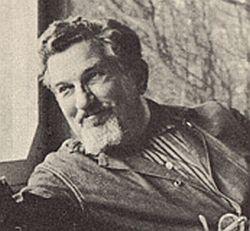
Who: Louis Slobodkin (born in Albany, NY, 1903)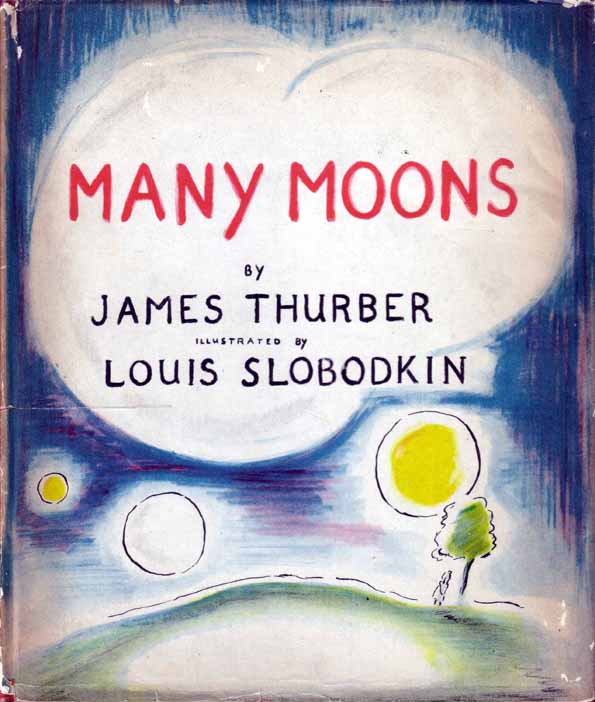
Book: Many Moons / Harcourt, Brace & Company / 1943
Writer: James Thurber
Plot: A lonely Princess decides that she wants the moon. She must have the moon. Her father, the King, demands that his court acquire it for her. Understandably, there are difficulties with the young princess's demanding request. Can the lowly Court Jester succeed in helping the Princess where the Royal Wizards, the Lord High Chamberlin and the Court Mathematician could not?
 Misc: In 1943, Slobodkin brought life to James Thurber's words in
Misc: In 1943, Slobodkin brought life to James Thurber's words in 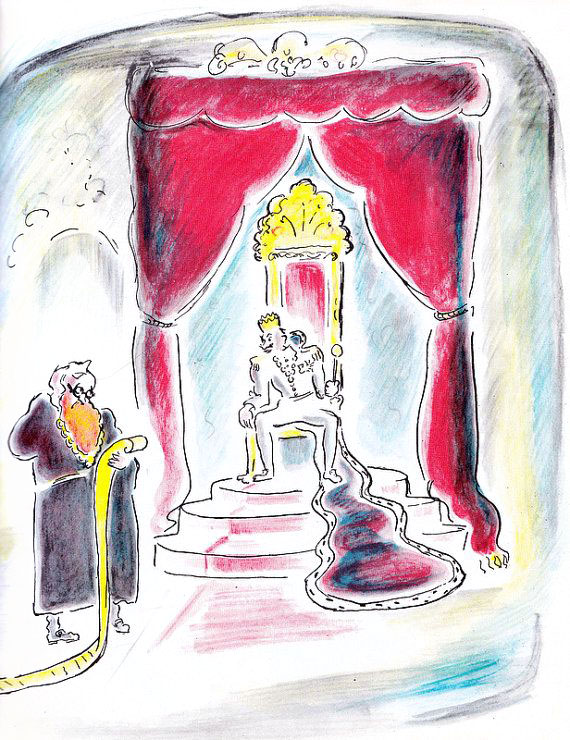 Many Moons, although that wasn't an area Thurber often needed help with. Thurber (The Secret Life of Walter Mitty) was a celebrated humorist, playwright, author, editor and cartoonist. Instead of using his own drawings for his tale of a forlorn Princess, Slobodkin's sparse, sketched out art was employed. Harcourt, Brace & Company clearly made the correct choice as it earned Thurber the Caldecott Medal the following year. After Many Moons, (also sold as The Princess that Wanted the Moon) Thurber went on to write numerous short stories as well as continue to contribute to The New Yorker alongside his friend and fellow writer E.B. White (who also knew a thing or two about children's books). Slobodkin went on to write and illustrate his own children's science fiction mini-franchise of books known as The Spaceship Under the Apple Tree series from 1952's eponymous first entry through 1972's final entry The Spaceship Returns to the Park.
Many Moons, although that wasn't an area Thurber often needed help with. Thurber (The Secret Life of Walter Mitty) was a celebrated humorist, playwright, author, editor and cartoonist. Instead of using his own drawings for his tale of a forlorn Princess, Slobodkin's sparse, sketched out art was employed. Harcourt, Brace & Company clearly made the correct choice as it earned Thurber the Caldecott Medal the following year. After Many Moons, (also sold as The Princess that Wanted the Moon) Thurber went on to write numerous short stories as well as continue to contribute to The New Yorker alongside his friend and fellow writer E.B. White (who also knew a thing or two about children's books). Slobodkin went on to write and illustrate his own children's science fiction mini-franchise of books known as The Spaceship Under the Apple Tree series from 1952's eponymous first entry through 1972's final entry The Spaceship Returns to the Park.
 Availability: In a strange move, the publisher commissioned a new artist, Marc Simont, and re-released the book in the mid-90's. Re-illustrating a book, especially to gain more attention when it's reissued is commonplace in the publishing world (see the works of Roald Dahl and L. Frank Baum for two famous examples), but it's quite rare to replace the illustrations of a Caldecott-winner. Simont, however, was no slouch. A multiple Caldecott Honoree and Medal Winner, Simont had also illustrated Thurber's popular children's book The 13 Clocks in 1950 after being personally asked to do so by Thurber himself. Luckily, if you're interested in Slobodkin's vision of the lunar loving Princess, it's still readily available in book stores and online. Note: Does your family have any copies of Slobodkin's Spaceship entries? If so, you may want to protect them. Depending on the condition of these beloved, but sadly out-of-print books, used paperback copies often start around $100 online. That's right - used paperback copies. If you have any new copies that happen to be laying around, you may even be able to build your own spaceship, as they are listed at approximately $2,000 and up online.
Availability: In a strange move, the publisher commissioned a new artist, Marc Simont, and re-released the book in the mid-90's. Re-illustrating a book, especially to gain more attention when it's reissued is commonplace in the publishing world (see the works of Roald Dahl and L. Frank Baum for two famous examples), but it's quite rare to replace the illustrations of a Caldecott-winner. Simont, however, was no slouch. A multiple Caldecott Honoree and Medal Winner, Simont had also illustrated Thurber's popular children's book The 13 Clocks in 1950 after being personally asked to do so by Thurber himself. Luckily, if you're interested in Slobodkin's vision of the lunar loving Princess, it's still readily available in book stores and online. Note: Does your family have any copies of Slobodkin's Spaceship entries? If so, you may want to protect them. Depending on the condition of these beloved, but sadly out-of-print books, used paperback copies often start around $100 online. That's right - used paperback copies. If you have any new copies that happen to be laying around, you may even be able to build your own spaceship, as they are listed at approximately $2,000 and up online.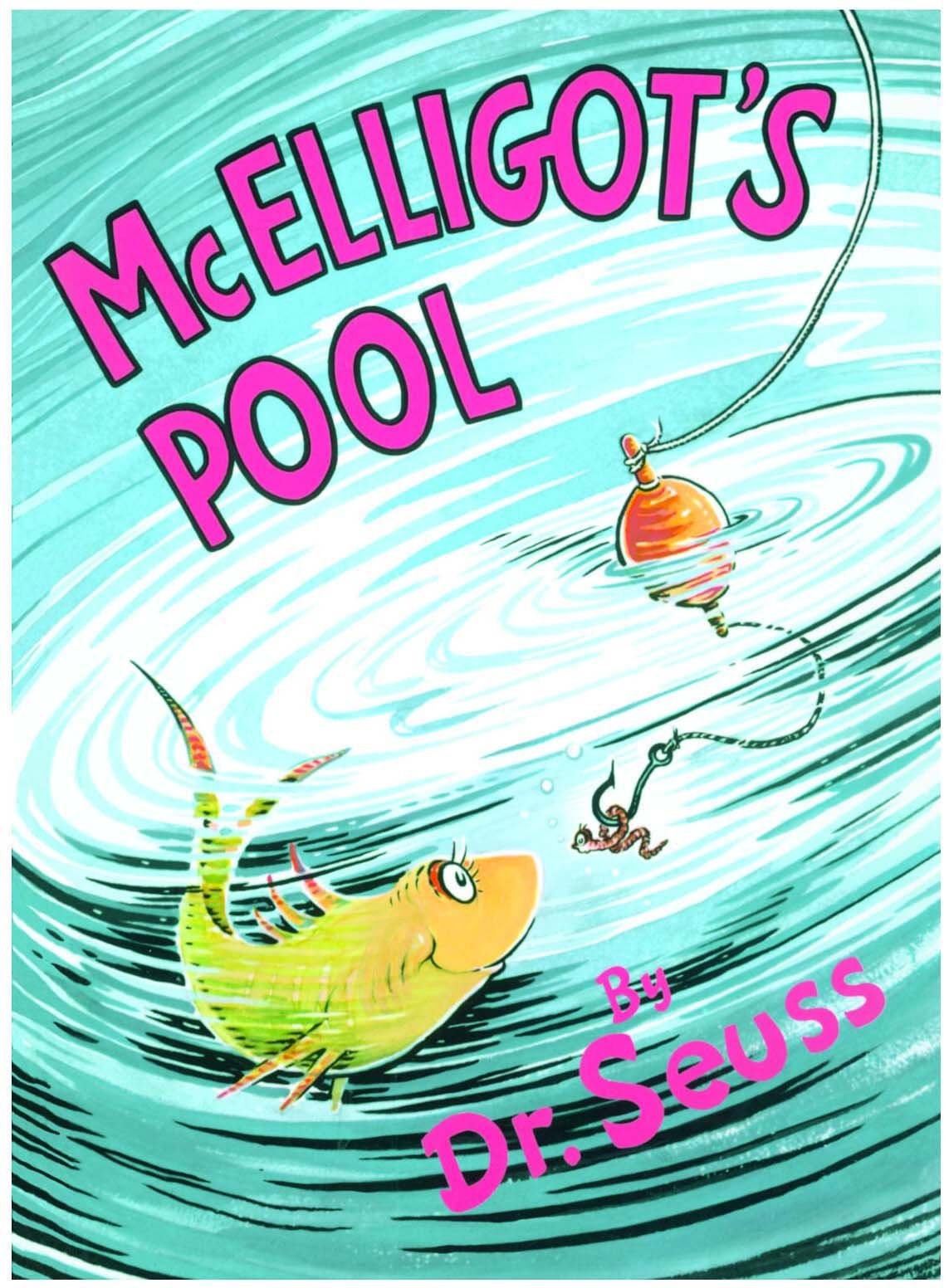
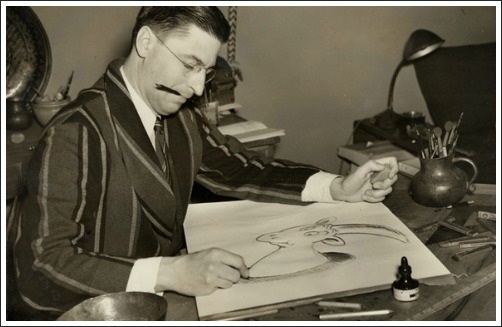
Who: Theodor Geisel, a.k.a. - Dr. Seuss (born in Springfield, MA, 1904)
Book: McElligot's Pool / Random House / 1947
Writer: Geisel
Plot: Young Marco has high hopes that he'll catch a fish in the local pond. But this isn't just any pond - oh, no, this is McElligot's Pool, which one of the locals reminds Marco is one of the most polluted, garbage-filled, fish-unfriendly bodies of water around. This summation of the cold, hard facts does not deter Marco. He is determined to catch a fish in McElligot's Pool. Be it goldfish, trout, or - fueled by his vivid imagination regarding not only the length and depth of McElligot's Pool but of its denizens - checkerboard patterned fish, a more equine-than-usual seahorse or a multi-headed eel.
Mis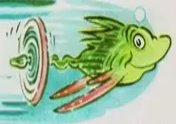 c: Seuss published five books within three years of each other, from 1937's And to Think That I Saw It on Mulberry Street through 1940's Horton Hatches the Egg. After this flurry of writing/publishing activity, Seuss didn't release his next book, McElligot's Pool, until seven years later. To be fair, most of the modern world was put on hold from 1940-1945 thanks to the war, and Seuss was no exception. He wrote and drew hundreds of
c: Seuss published five books within three years of each other, from 1937's And to Think That I Saw It on Mulberry Street through 1940's Horton Hatches the Egg. After this flurry of writing/publishing activity, Seuss didn't release his next book, McElligot's Pool, until seven years later. To be fair, most of the modern world was put on hold from 1940-1945 thanks to the war, and Seuss was no exception. He wrote and drew hundreds of  political cartoons during World War II, many of which directly attacked foreign leaders including Hitler and Mussolini, while also saving room to lambaste former American hero Charles Lindbergh for his questionable views on the foreign policy future of the United States. McElligot marked the return of Seuss's earliest protagonist, Marco, from Mulberry Street. It also marked Seuss's first time using watercolors, opposed to his usual pen and ink me
political cartoons during World War II, many of which directly attacked foreign leaders including Hitler and Mussolini, while also saving room to lambaste former American hero Charles Lindbergh for his questionable views on the foreign policy future of the United States. McElligot marked the return of Seuss's earliest protagonist, Marco, from Mulberry Street. It also marked Seuss's first time using watercolors, opposed to his usual pen and ink me thod, to illustrate his story. Random House loved the new, multi-textured look with colors from each spot of the spectrum, but were wary of the costs involved in publishing a book of its length with full color watercolor prints. They compromised by alternating between black and white pages and fully painted pages. Instead of upsetting the balance of the book's beauty, the sharp, monochromatic pages only help in making the rich watercolors jump and swim off th
thod, to illustrate his story. Random House loved the new, multi-textured look with colors from each spot of the spectrum, but were wary of the costs involved in publishing a book of its length with full color watercolor prints. They compromised by alternating between black and white pages and fully painted pages. Instead of upsetting the balance of the book's beauty, the sharp, monochromatic pages only help in making the rich watercolors jump and swim off th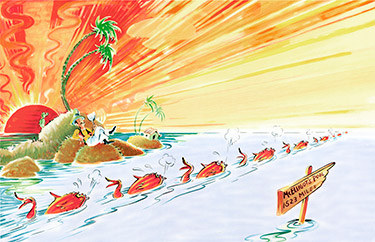 e page. Despite being considered one of the most beautifully rendered of all of the Seuss books, McElligot's Pool was a Caldecott Honoree but did not win the Medal, instead seeing it awarded to Roger Duvoisin for his work in White Snow, Bright Snow. Unlike many other works by Seuss, McElligot's Pool did not receive a major adaptation, though the basic language and text of the story was reproduced in 2000 though the song "It's Possible" from Act I of Seussical: The Musical. Veering from the narrative slightly, the musical recasts the role of Marco to a Who named JoJo. Remarkably, though two more Seuss books would go on to receive Caldecott Honors (1950's Bartholomew and the Oobleck and 1951's If I Ran the Zoo), Geisel was never awarded the Caldecott Medal.
e page. Despite being considered one of the most beautifully rendered of all of the Seuss books, McElligot's Pool was a Caldecott Honoree but did not win the Medal, instead seeing it awarded to Roger Duvoisin for his work in White Snow, Bright Snow. Unlike many other works by Seuss, McElligot's Pool did not receive a major adaptation, though the basic language and text of the story was reproduced in 2000 though the song "It's Possible" from Act I of Seussical: The Musical. Veering from the narrative slightly, the musical recasts the role of Marco to a Who named JoJo. Remarkably, though two more Seuss books would go on to receive Caldecott Honors (1950's Bartholomew and the Oobleck and 1951's If I Ran the Zoo), Geisel was never awarded the Caldecott Medal.
